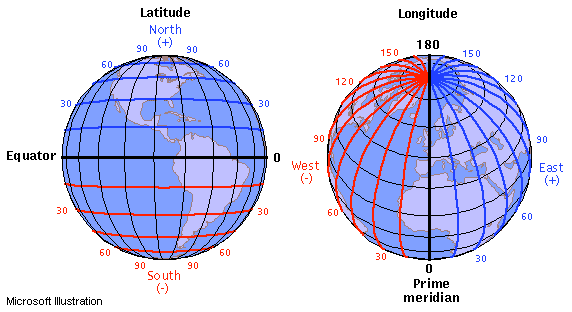Back to: GEOGRAPHY SS1
Welcome to class!
In today’s class, we will be talking more about latitude and longitude. Enjoy the class!
Latitude and Longitude II

Calculation of distances and local time
The distance between one line of the latitude and another is 111km. Two points lying North or South of the equator are subtracted to get the latitude difference.
Example:
Calculate the appropriate distance in a straight line between Tama (lat 60N) and London (lat 520 N).
Solution
Latitude difference = 520 – 60 = 460
Average distance = 111km
460 = 46 x 111km = 5, 106km
Calculation of local time and longitude
The earth rotates at an angle of 10 in 4minutes; 150 in 1 hour and 3600 in 24 hours.
Example:
If the time in Cameroon 300E is 3:00 pm. What time will it be in London?
Solution
300 = 30 x 1 x 4minutes = 120 minutes = 2 hours
Time in London = 3:00pm – 2 hours
15 hours – 2 hours
Time in London = 13hours
Time in London = 1:00 pm
International dateline
Time and time zones:
Time zones are based on the fact that Earth moves through 15 degrees of longitude (imaginary vertical lines drawn on the globe) each hour. Therefore, there are 24 standard time zones (24 hours x 15º=360º), which is the sum of angles in a circle.
Time zones are counted from the Prime Meridian (0º longitude), which runs through Greenwich, England. Each time zone is based on a central meridian, counted at 15º intervals from the Prime Meridian, and extends 7½º to either side of the central meridian.
For example, Nigeria lies between the longitudes 3° and 14° E of the Greenwich Meridian, much of which is in the zone of the 15ºE central meridian (GMT+1), and the time zone for this meridian includes all locations between 7½ºE and 22½ºE.
Lagos though lies at longitude 3° 27′ E and falls under the time zone for the Greenwich Meridian ( 7½°W – 7½°E), but for the sake of simplicity, and so that all parts of the country will operate at one time, it has been grafted into the GMT+1 time zone.
The need for standard time zones emerged with the spread of high-speed transportation systems – first, trains and later, aeroplanes. The system of time zones that is in use till date was agreed upon by delegates from 27 countries who met in Washington DC in 1884.
Countries like the United States operate at 4 time zones – while it is 9 am (GMT -5), Wednesday in New York; it is 6 am (GMT -8), Wednesday in Los Angeles – because the country spans about 3,000 miles (over 4,800 km) from East to West. But China, though spanning over 3,000 miles (over 5,000 km) from East to West operates at just one-time zone (GMT+8).
Countries like New Zealand start the day first, followed by Japan, Australia, Russia, China and India, followed by countries in Europe and Africa, followed by countries in North and South America, and ending on islands out in the Pacific Ocean, like Hawaii and finally Samoa.
Calculation of distance using lines of latitude
Procedures:
- locate the two places involved
- find the latitude difference between the two places
Note:
- North-North= subtract
- North-South= add
- South-North= add
- Equator-North= add or subtract
- Equator-South= add or subtract
- Multiply the latitude difference by 111km
1°=111km (1° of latitude is approx. 111km on land)
Example 1:
Calculate the distance between S. Africa (30°S) and Spain (40°N)
Solution
Lat. diff. =30°S+40°N=70°
since 1°=111km
therefore, 111×70=7770km
The distance b/w S. Africa and Spain=7,7770km
Evaluation
- What is the distance between place A (lat.20°S) and place B (lat.51oN)?
- What is the distance between the Equator and Lagos (14°N)?
Calculation of local time using the lines of longitude
Procedures:
- locate the places involved
- find longitude difference
- conversion to time
- adjust time according to the direction of movement(west or east)
Examples:
- If the time at town A(long.75°W) is 5.00 pm on Friday, what will be the time and day at town B(long.120°E)?
Solution
i) Longitude difference = 75°+120°=195°
ii) conversion to time = 195 (since 15°=1hr)=13hrs * 15
iii) adjustment of time according to the direction of movement =5pm+13hrs (add, since it is due east) = 6.00am on Saturday
Evaluation
Explain how to use longitude to calculate local time
General evaluation
When it is 2.00 pm in GMT; what is the time in
- Ethiopia (45oE)?
- Los-Angeles (75oW)?
- Nigeria (15oE)?
Reading assignment
Essential Geography, O.A. Iwena, Pages 17-19.
Theory
Attempt questions 3(a), 3(b), and 4(b) on page 21 of Essential Geography.
In our next class, we will be talking about the Structure of the Earth- the Outer Zone. We hope you enjoyed the class.
Should you any further question, feel free to ask in the comment section below and trust us to respond as soon as possible.

Which date is our next class
The classes are already here. Find the class, subject and topic of your choice. You can access them for FREE!
really love this page
even though i don’t have textbooks
class note site is really helping me out
THANK YOU CLASS PREFECT
waooooow, very understandable and comprehensive…. I love this ❤️
wow it is nice.